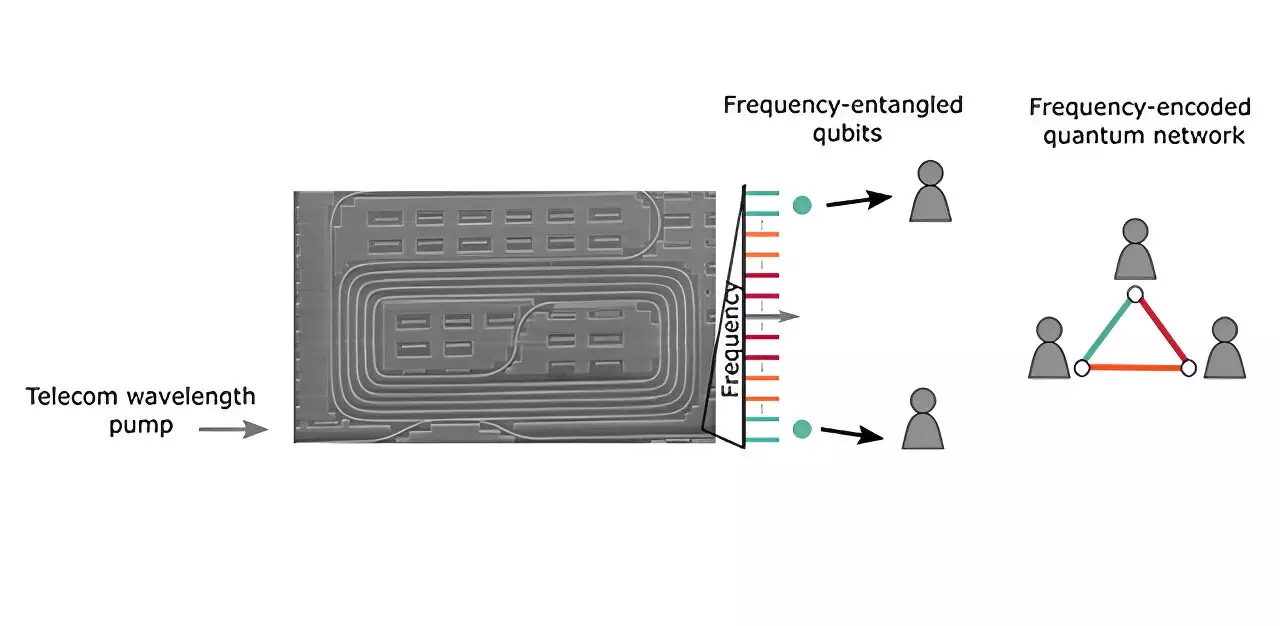Recent research in quantum technology has achieved a significant milestone by harnessing the frequency dimension within integrated photonics. The manipulation of light within tiny circuits on silicon chips has long been seen as promising for quantum applications due to its scalability and compatibility with existing telecommunications infrastructure. Researchers from the Centre for Nanosciences and Nanotechnology (C2N), Télécom Paris, and STMicroelectronics (STM) have made a breakthrough in this field by developing silicon ring resonators capable of generating over 70 distinct frequency channels spaced 21 GHz apart on a footprint smaller than 0.05 mm2. This advancement allows for the parallelization and independent control of multiple qubit-gates, bringing us one step closer to practical quantum networks.
Through the use of integrated ring resonators, researchers have successfully generated frequency-entangled states using a process known as spontaneous four-wave mixing. This technique enables photons to interact and become entangled, a crucial capability for building quantum circuits. The key innovation lies in the ability to exploit narrow frequency separations to create and control quantum states efficiently. This breakthrough has the potential to revolutionize industries reliant on secure data transmission, offering unprecedented levels of computational power and data security.
Scalability and Practicality
What sets this research apart is its practicality and scalability. By leveraging the precise control offered by silicon resonators, the researchers have demonstrated the simultaneous operation of multiple qubit-gates using just three off-the-shelf electro-optic devices. This achievement enables the creation of complex quantum networks where multiple qubits can be manipulated independently and in parallel. Experimentation at C2N confirmed the fidelity and coherence of the quantum states generated, marking a significant step towards practical quantum computing.
The researchers have also achieved a milestone in networking by establishing what they believe to be the first fully connected five-user quantum network in the frequency domain. This accomplishment opens up new possibilities for quantum communication protocols, which rely on secure transmission of information encoded in quantum states. Dr. Antoine Henry notes that leveraging frequency-bin for large-scale applications in quantum information offers perspectives for scalable frequency-domain architectures for high-dimensional and resource-efficient quantum communications.
The implications of this research are vast. By harnessing the frequency dimension in integrated photonics, key advantages such as scalability, noise resilience, parallelization, and compatibility with existing telecom multiplexing techniques have been unlocked. The future of quantum technologies holds immense potential, with integrated photonics platforms paving the way for applications in quantum computing and secure communications. Continued advancements in this field could revolutionize industries reliant on secure data transmission, offering unparalleled levels of computational power and data security.
The groundbreaking research conducted by the teams at C2N, Télécom Paris, and STM represents a significant leap forward in the field of quantum technology. By harnessing the frequency dimension in integrated photonics, researchers have laid the groundwork for the development of practical quantum networks that offer secure communication and advanced computational capabilities. As we move closer to realizing the full potential of quantum technologies, this milestone serves as a beacon, guiding us towards a future where quantum networks play a crucial role in the way we communicate and process information.


Leave a Reply